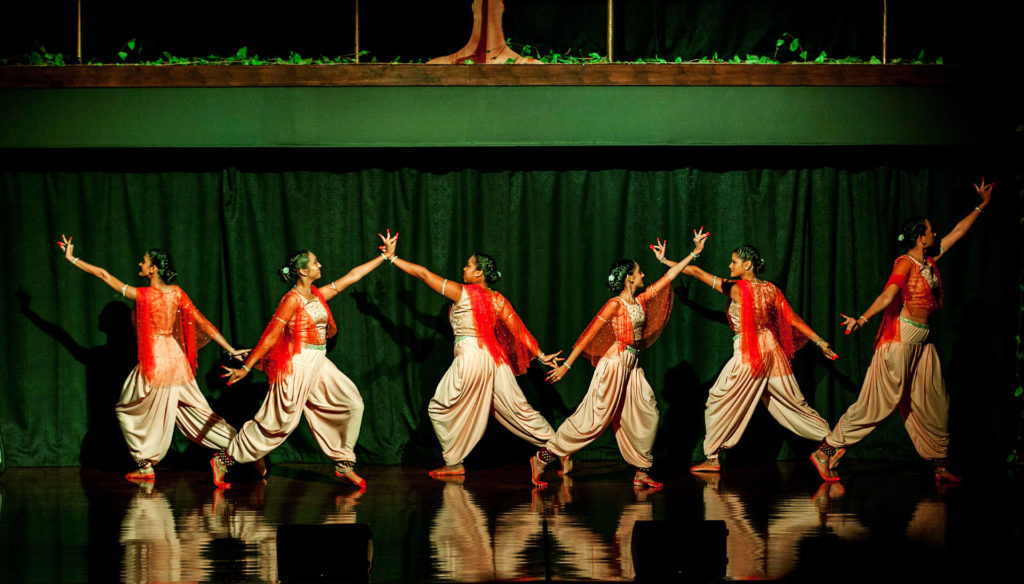We are meeting at noon. It’s because she begins teaching some days at 7 am, and finishes close to lunchtime. But even before that, she does her own training online with her teachers from India at 4.30 am.
“It takes a toll, you know,” says Alana Rajah, when in our warmup conversation I mention that I am planning on taking a course that will begin at 4 am,five days a week. “That was how I got injured. At 4.30 in the morning, my body is still waking up here, while they [in India] are nine and a half hours ahead. Nowadays I am constantly tired.”
Rajah’s fatigue is only natural. She has been on this schedule for the past year. 4.30 am daily online training — the COVID-19 pandemic has made travel to India impossible — 7 am departure for work, 5 pm return home to begin teaching her own dance students.
“When I told my family that I was going to pursue dance, they very honestly told me that it would be a very difficult life,” she recalls. “My adulthood would be quite a strain, because dance does not have that safety net, that financial cushion . . . I valued their opinion, and they were very much correct,” she says, laughing, “but I didn’t feel bad about it. I always felt that I was strong enough to work as well as pursue my career as a teacher and performer. I prepared myself mentally to work a full-time job and come home to work another full-time job, because it isn’t something that we as artists can control. Even though we are born with a passion, or a talent, or the art within us, it’s a societal fact that it is an industry that does not afford you a luxurious lifestyle.”
Rajah’s chosen artform is Bharatanatyam, one of the oldest classical dance forms of India, and perhaps one of the most physically demanding. “The physical body lends itself to the practical aspect,” she explains. “We have yoga and kalari. Those are two things you learn first to build leg strength to help your body become accustomed to the geometric lines or patterns that make up the style of Bharatanatyam.”
At the Adavallan Art Academy, which she established with the vision of creating her own dance school in Trinidad, Rajah does not sacrifice this aspect of her students’ dance training. Diet and fitness are essential disciplines, even for students as young as five years old. “I feel that discipline is something that does not hold true to Caribbean culture or Trinidadian culture,” she says. “It’s something we don’t have as a people. It’s something we don’t see even in the highest of positions, from government to public service to customer service. So, for me, it was my personal goal to inject that into the society.”
And how does she contextualise herself as a Bharatanatyam performer in Trinidad, where up to today Indian arts are seen as rooted in India rather than Trinidad? “It’s unfortunate,” says Rajah. “All of us exist within the same space, and there are things that lend to the beauty of our culture, our cultural identity, and Indians make up a large portion of that population.”
Perceptions of artforms like Bharatanatyam are slowly changing, at least in relation to the outside world. Social media has been instrumental in the growing awareness of the Caribbean Indian diaspora and its artists. In 2020, at the annual South African Indian Dance Alliance’s Global Dance Conference, participants from Guyana and Trinidad were invited for the first time, to work with other dancers and share experiences as artists of the Indian diaspora. “We are becoming more embraced and recognised,” says Rajah. “Because even for India, it took a long time for them to appreciate dancers of the diaspora outside of India . . . they didn’t understand the history of Indians being taken from India and settling across these various countries and islands. That is a concept that is now settling within their minds. And that appreciation is growing, which I am so grateful for.”
In Trinidad and Tobago, before Rajah’s emergence, there had been only one practitioner of Bharatanatyam dance. Under the tutelage of Rajkumar Krishna Persad at the Trinidad School of Indian Dance, a basic foundation was enough to take Rajah on a quest to deepen her knowledge of an artform that dates back approximately two thousand years.
The Internet opened the world of Indian classical dance to her. Rajah’s research in Bharatanatyam brought up names like E. Krishna Iyer, Balasaraswati, and Rukmini Devi, a group of artists who were commonly known as the Revivalists. They were responsible for introducing Bharatanatyam to a public stage. In previous centuries, Bharatanatyam was practiced only by the Devadasis, women who lived within the inner sanctums of the temples of Tamil Nadu and were considered to be the brides of the gods. Among the Revivalists, Rukmini Devi Arundale, founder of the Kalakshetra Foundation in Chennai, was the one to whom Rajah was most attracted.
“She was a Brahmin, so she went against all of her cultural conditionings and beliefs to learn this artform, and created this huge institute for Bharatanatyam,” Rajah explains. “There were flocks of students who went to specialise in the artform, and left Kalakshetra as budding artistes. That is something I wanted to do. Not only go to her institute, but do the exact same thing that she did for her country, because I felt when I was young I would have loved to have a Rukmini Devi as my mentor . . . I would have felt so much better existing with the passion that I had, because this was something that was not mainstream.”
Rajah’s quest took her on scholarship to Kalakshetra, an institution that is “like military camp for dance,” as she describes it. There, after four years of intense study to earn her Diploma in Dance, it was back in Trinidad that her trials would begin.
“After doing all of that, and coming back to Trinidad to try and share your knowledge or add that artform into the cultural community here, you are then labelled with, ‘You feel you know. You is it because you went away and study’ — which is so unfortunate. It really breaks down all of your spirit . . . So you really have to crawl into a hole and create magic again, just to escape the ole talk.”
Additionally, Bharatanatyam is linguistically and musically different to most other Indian classical forms in Trinidad. The musical heritage of Indians in Trinidad is mostly rooted in northern Indian folk music and dance. Those who have studied classical Indian music are primarily educated in north Indian traditions. Bharatanatyam dance introduces a south Indian aesthetic, language, and rhythm.
In a traditional Bharatanatyam recital, the dance is performed through facial expressions and hand gestures. Through these, the rasas are communicated. In the Indian classical tradition, the concept of rasa — roughly translated as essence or flavour — is critical to performance. The expression of the navrasas, or the nine emotions, is the responsibility of musicians and dancers alike. Communicating these effectively to audiences is one of the main goals of performance. As such, in the Indian classical tradition, music is defined as a trilogy: dance, instrumental music, and song.
As Rajah explains, “When you learn any of the eight forms of Indian classical dance, there are many things that you have to learn simultaneously with it. Indian classical music, it’s like a sub-main to your dance. You have to learn percussion, which is the inherent rhythm of the universe. It’s that structure, the time cycle of how you would set your music to dance, so you have to be very knowledgeable about that.”
In Trinidad, the challenge was adaptation of this knowledge. “In the Carnatic musicians’ setup, the instruments used for Bharatnatyam are the mridangam [a two-headed drum], veena [similar to a lute], flute, violin, nattuvangam [cymbals], and the vocalist. We do have drums, but those artistes improvise freely, they aren’t trained in the music. We do not have veenas or veena artists. We have the violin, we have the flute, but the entire genre is different. They aren’t at all trained in Carnatic music. I’ve now had to explore working with the tabla, because that is what is available here. And sitar, as well as not having a natuvanar or vocalist. Even if I have a vocalist, the music can’t be set to a particular rhythmic cycle, as we would in Carnatic music, because that concept isn’t practiced by them. And if I’m dancing, I’m not able to do the nattuvangam, which is like the most important part of the orchestra for Bharatnatyam. So I’ve had to try to find ways to work around it.”
Na veena na ragam, na mridangam na talam — “Neither veena nor ragas, neither mridangam nor rhythm” — the phrase could very well be the beginning of another text, not the Natyashastra, the ancient Indian treatise on dance and performance, but a Caribbean one.
Rajah sees this as lending to creativity and presentation. “It just takes a bit more out of both sides, the musicians and the dancers.” In addition, she’s started pre-recording a spoken introduction for the performance — “for the audience to understand what will be unfolding, what they are supposed to feel, what they will be seeing on the stage.”
This feels like another coming of age story in the history of Bharatanatyam. It continues the narrative of resilience and imagination — of those who dared to cross boundaries, and of women, most importantly, who challenged the order of things. Transplanted in Trinidad, it is yet another transformation of the form, despite Rajah’s attempts to retain the purity of form.
Improvisation, after all, is a feature of Bharatanatyam’s history, and Alana Rajah, with her relentless drive to perfect her art and establish her own version of Kalaskshetra in the Caribbean, is in fact a pioneering spirit, charting a course for a future generation.

